
Manchester Oxford Road railway station is a railway station in Manchester, England, at the junction of Whitworth Street West and Oxford Street. It opened in 1849 and was rebuilt in 1960. It is the third busiest of the four stations in Manchester city centre.

Hulme is an inner city area and electoral ward of Manchester, England, immediately south of Manchester city centre. It has a significant industrial heritage.
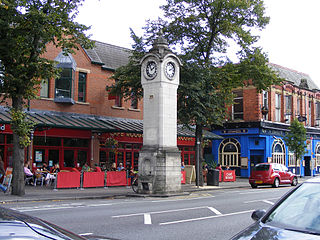
Didsbury is a suburb of Manchester, England, on the north bank of the River Mersey, 5 miles south of Manchester city centre. The population at the 2011 census was 26,788.

Hindley is a town within the Metropolitan Borough of Wigan in Greater Manchester, England. It is three miles (4.8 km) east of Wigan and covers an area of 2,580 acres (1,044 ha). Within the boundaries of the historic county of Lancashire, Hindley borders the towns and villages of Ince-in-Makerfield, Aspull, Westhoughton, Atherton and Westleigh in the former borough of Leigh. In 2001, Hindley had a population of 23,457, increasing to 28,000 at the 2011 Census. It forms part of the wider Greater Manchester Urban Area.

Deansgate is a railway station in Manchester city centre, England, 1,100 yards (1 km) west of Manchester Piccadilly, close to Castlefield at the junction of Deansgate and Whitworth Street West. It is part of the Manchester station group.

Lowton is a village within the Metropolitan Borough of Wigan, in Greater Manchester, England. It is around 2 miles (3 km) from Leigh, 7 miles (11 km) south of Wigan and 12 miles (19 km) west of Manchester city centre. The settlement lies across the A580 East Lancashire Road.
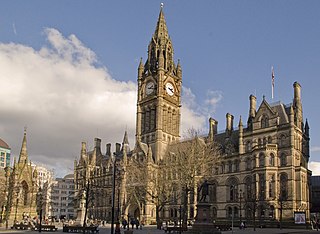
The architecture of Manchester demonstrates a rich variety of architectural styles. The city is a product of the Industrial Revolution and is known as the first modern, industrial city. Manchester is noted for its warehouses, railway viaducts, cotton mills and canals – remnants of its past when the city produced and traded goods. Manchester has minimal Georgian or medieval architecture to speak of and consequently has a vast array of 19th and early 20th-century architecture styles; examples include Palazzo, Neo-Gothic, Venetian Gothic, Edwardian baroque, Art Nouveau, Art Deco and the Neo-Classical.
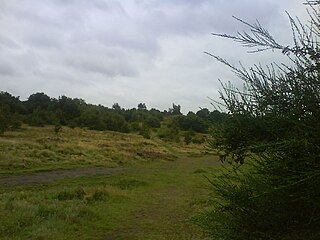
Kersal Moor is a recreation area in Kersal, Greater Manchester, England which consists of eight hectares of moorland bounded by Moor Lane, Heathlands Road, St. Paul's Churchyard and Singleton Brook.
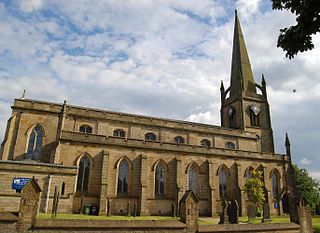
St George's Church is an Anglican parish church serving Tyldesley and Shakerley in Greater Manchester, England. It is part of Leigh deanery in the archdeaconry of Salford and the diocese of Manchester. The church, together with St Stephen's Church, Astley and St John's Church, Mosley Common is part of the united benefice of Astley, Tyldesley and Mosley Common.
Walter Carroll was an English composer, music lecturer and author. He was born at 156 Great Ducie Street in the Cheetham district of Manchester.

St Mary Magdalen Roman Catholic Church, Mortlake, is a Roman Catholic church in North Worple Way, Mortlake, in the London Borough of Richmond upon Thames. The church is dedicated to Jesus' companion Mary Magdalene. It is located just south of Mortlake High Street and the Anglican St Mary the Virgin Church. St Mary Magdalen's Catholic Primary School is just north of the churchyard.

Sir James Farmer was an English manufacturer and the mayor of the County Borough of Salford, England, for two terms between 1885 and 1887.

St John's Church, Manchester, also known as St John's, Deansgate, was an Anglican parish church in Manchester, England, established in 1769 and demolished in 1931. Its site is now that of St John's Gardens, situated between Lower Byrom Street, Byrom Street and Quay Street.
St Mary's Church was an Anglican parish church in Manchester, England.
John Clowes was an English cleric and Fellow of Trinity College, Cambridge. Despite his position in the Anglican church, for which he served as Rector of St John's Church, Manchester from 1769 until 1831, he was a noted disciple of Emanuel Swedenborg and did much to propagate his ideas in the Manchester area.
Ancoats Station was a goods station operated by the Midland Railway to handle freight traffic in Manchester, England, on land bought in the Ancoats district from the Mosley family, whose adjacent family seat Ancoats Hall was also taken over by the railway company for business use.

The following is a timeline of the history of the city of Manchester in north west England.
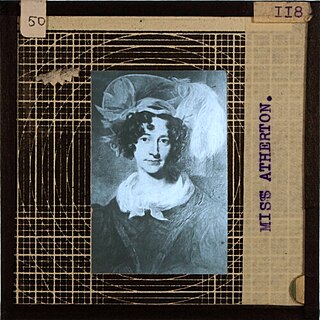
Eleanora Atherton was an English philanthropist best known for her work in Manchester, England. At the time of her death, she was one of the richest British women in the nineteenth century.
Manchester is a city in Northwest England. The M3 postcode area of the city includes the western part of the city centre. The area contains 79 listed buildings that are recorded in the National Heritage List for England. Of these, five are listed at Grade I, the highest of the three grades, two are at Grade II*, the middle grade, and the others are at Grade II, the lowest grade.

St John Street is a street in central Manchester, England. It consists mainly of late Georgian and Regency era terraced houses. Laid out between 1770 and 1830, the street runs roughly east–west between Deansgate and Byrom Street, terminating in an urban park, formerly the site of St John's Church, at its eastern end. Originally built for the prosperous Manchester upper-middle classes, by the 20th century it had become the preserve of the medical and legal professions. In the 21st century, some of the buildings are being reconverted to residential use. The only surviving Georgian terraced street in central Manchester, many of its buildings are listed.
















